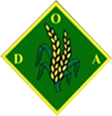1. Seed
- For growing purpose
- Any seeds which have been systematically maintained and produced to obtain identical original genes and morphology of a crop which in turn is in conformity with the seed standard of different seed classes
2. Grain
- For eating purpose
- Grown continuously for many generations
- Poor genetic quality
- Low yield
- Low quality
3. Good quality seed
- High yield
- Palatablility
- Resistant to pests and diseases
- Adaptable to any locals
- Response to fertilizer
4. Pure seed
- The Seeds of any variety which is genetically pure, but free from seeds of other varieties, weed seeds, unfertile/sterile seeds, and inert materials
- Good field establishment
- Uniform plant growth
- Uniform flowering
- Stems, branches, leaves, flowers and fruits are not different from original
- Free from other crop seeds and weed seeds
5. Advantages of using pure and quality seed
- Could maintain the good quality of original gene
- Good germination with fast growth rate
- Efficient use of fertilizer, moisture, light etc.
- Better crop stand
- Resistance to environment and pests
- Free from weeds
- Free from pests
- Uniform ripening, and low harvest lost
- Free from other varieties
- Higher yield (10-20%)
6. Seed Classes
Self Pollinated Crops
1. Breeder Seed
2. Foundation Seed
3. Registered Seed
4. Certified Seed
Cross Pollinated Crops
1. Breeder Seed
2. Foundation Seed
3. Certified Seed
7. Offtype
- Plants which is the same species as the cultivated crops but with different morphological characters (differences in plant type, branches, leaf (form, color, hairiness), flower (color, size), ripeness, tillering capacity, resistance to disease etc,)
- Different variety with cultivated crop
8. Prevention of impurity seeds
- Setting up of the isolation distance in the seed production farm
E.g. Rice (10 feet), wheat (10 fee), Peanut (11 feet), Green gram, black gram, chick pea, butter pea (10 feet), Cotton (150/100 feet), Pigeon pea (60/30 feet), Seed corn (600/300 feet), sesame (300/150 feet), sunflower (2640 feet)
9. Seed selection and seed saving
- Selection of seed which is adaptable to the environment and locality and which has potential market
- Selection of seed with environmentally and locally adaptability and with market potential
- Obtaining of seeds in time
- Saving of seeds (at 1-1.5 basket/acre rate), or saving of seeds (6-8 pyi/acre) for pure seed
- Saving of seeds depending on requirement
- Necessity of recommended seeds in conformity with the seed standard
- Using of seeds with recommended seed standard
- (Use recommended registered seeds with blue label to produce certified seeds)
- Keep the seed bag at the place with good ventilation, with no
10. Site selection
- Place with easy irrigation and drainage
- Fertile soil
- Set priority to choose the place where the same crop was previously grown
- Place with abundant sunlight and no shade
- abstain the field where the previous crops was seriously infested with pests
- Refrain the field where there are unacceptable weeds (weeds that are difficult to control, poisonous)
- Choose the place which is at least 10 feet away from field of other varieties to prevent mixing with other varieties
- The land should be level, with good water holding capacity, and uniform soil fertility.
- Non-uniform plant growth due to non-uniform soil fertility may cause non-uniform ripeness which may in turn create problems in rogueing
11. Cautions in pure seed production
- Be the right seed flow at respective seed class
- Be the right planting technique
- The systematic be in accordance with the stipulation at every step of producing pure seed
- Use those seeds after testing seed quality that are in conformity with the seed standard
- It should be keep in mind that if the activities are not in accordance with the stipulation, the breeder seeds will produce grain though the seed source obtained is right.

